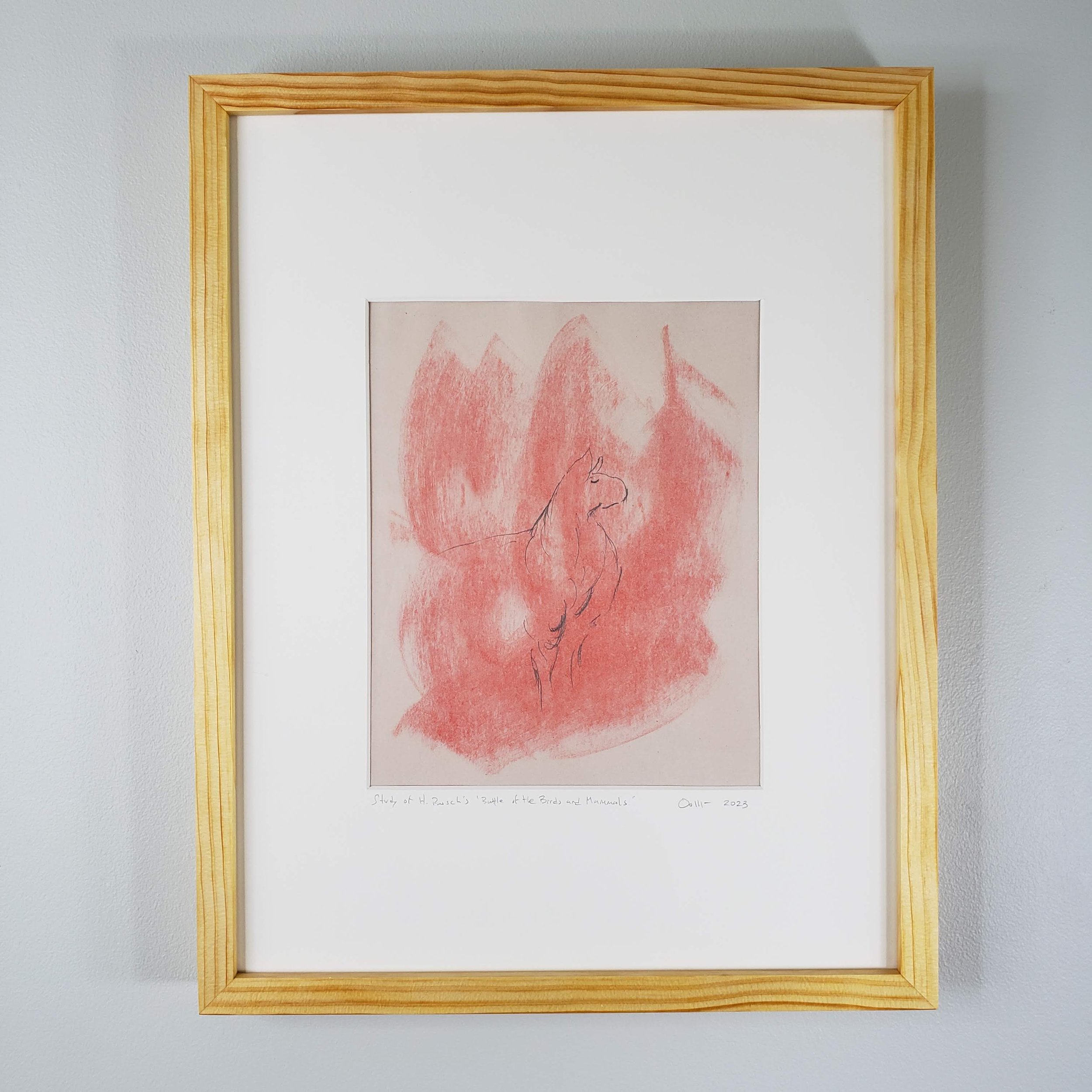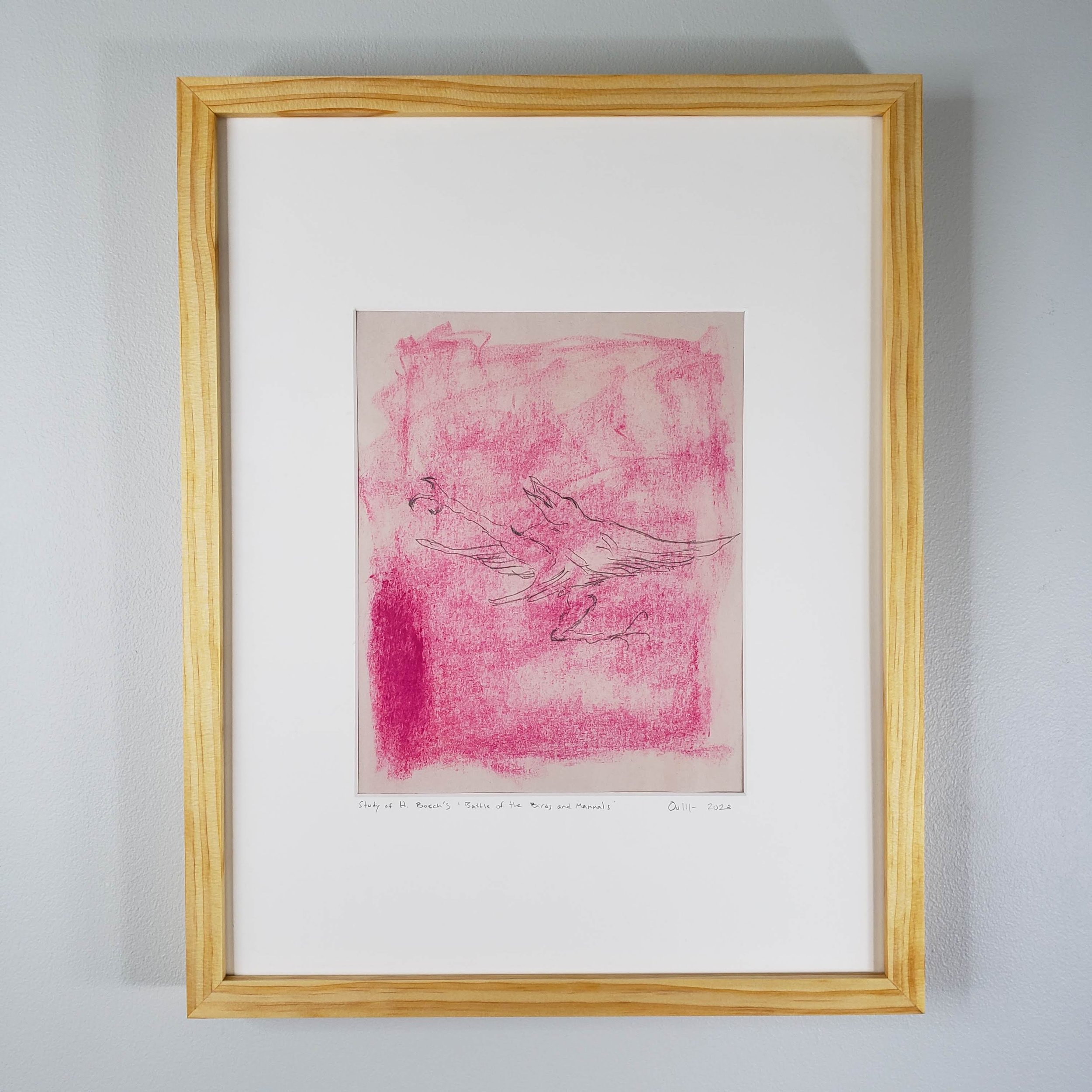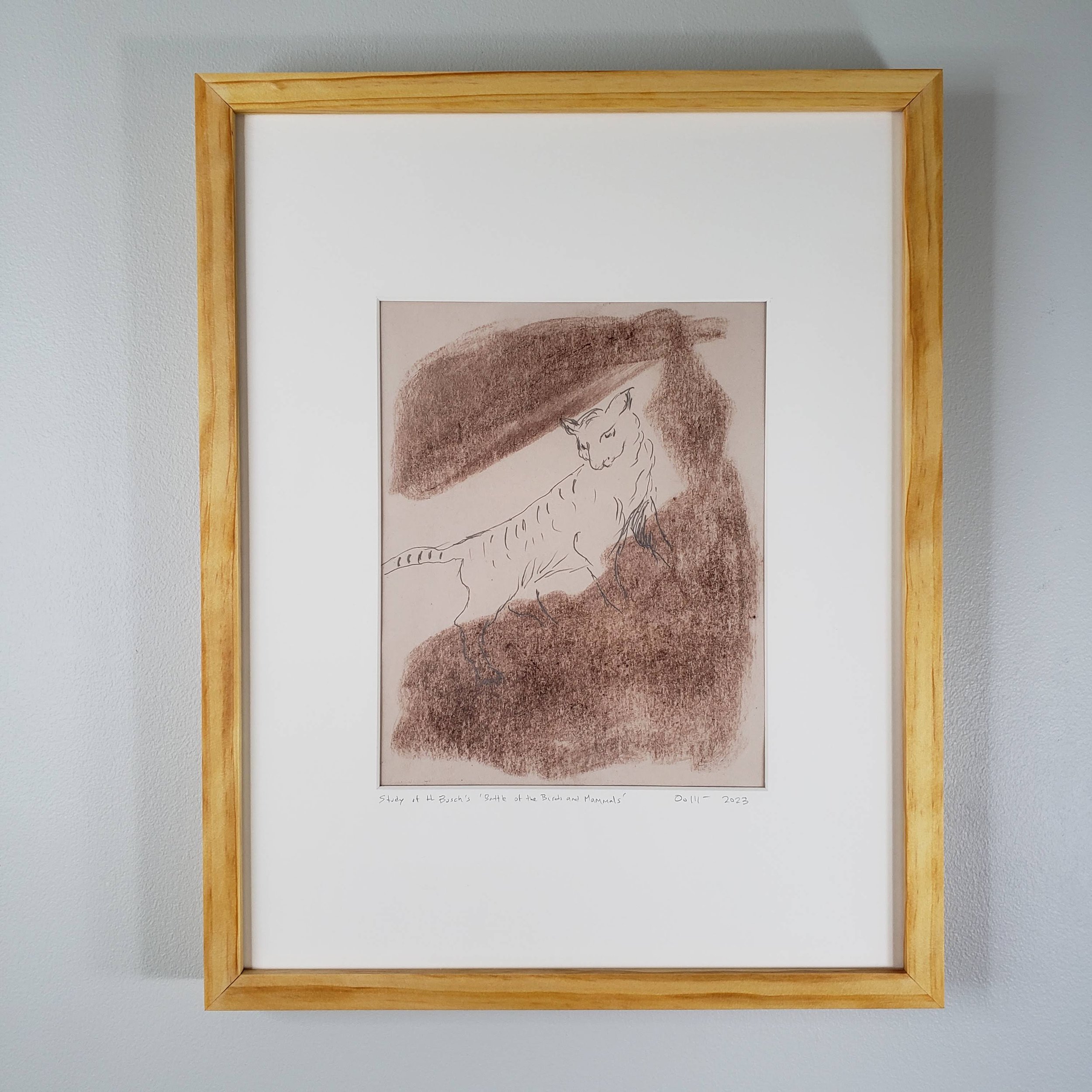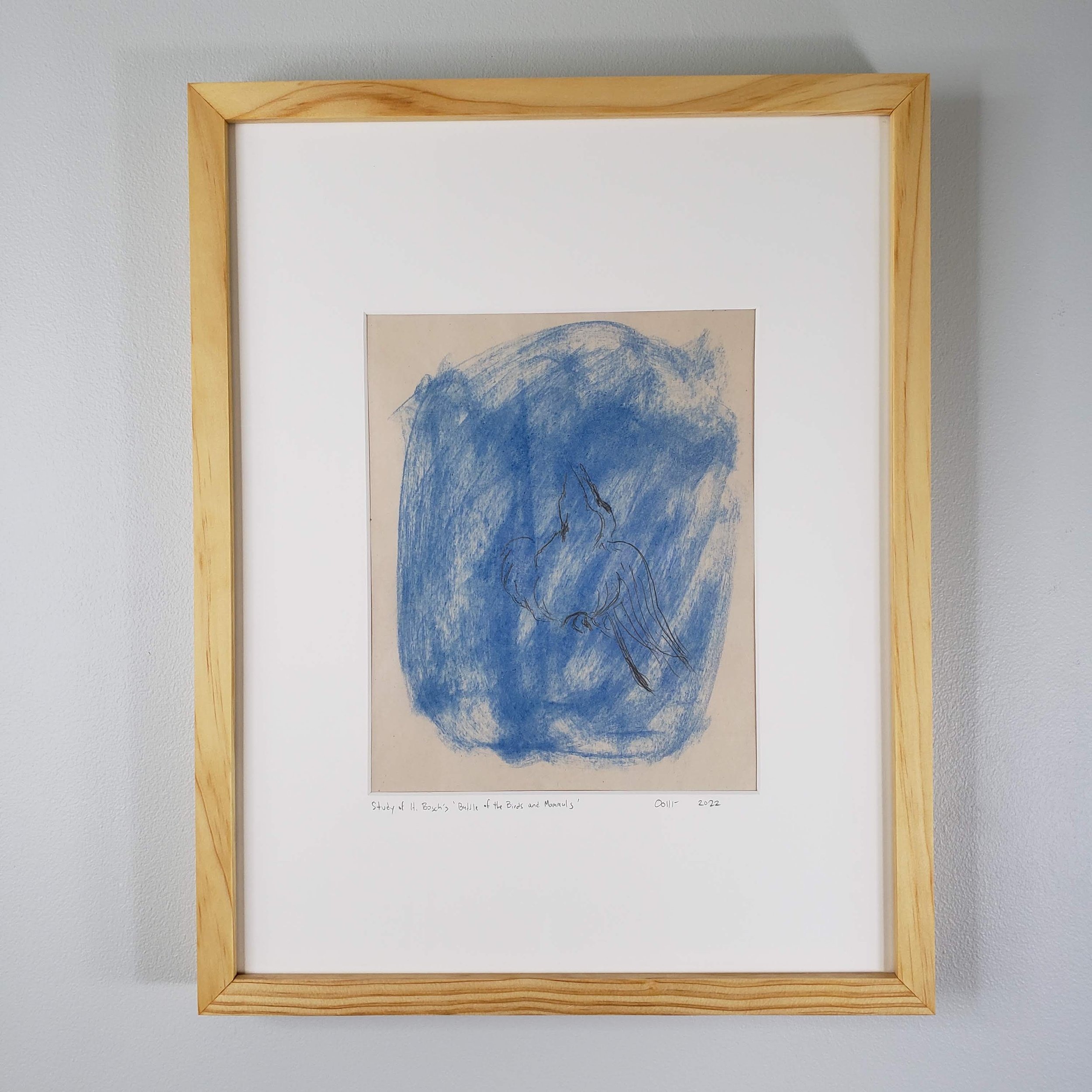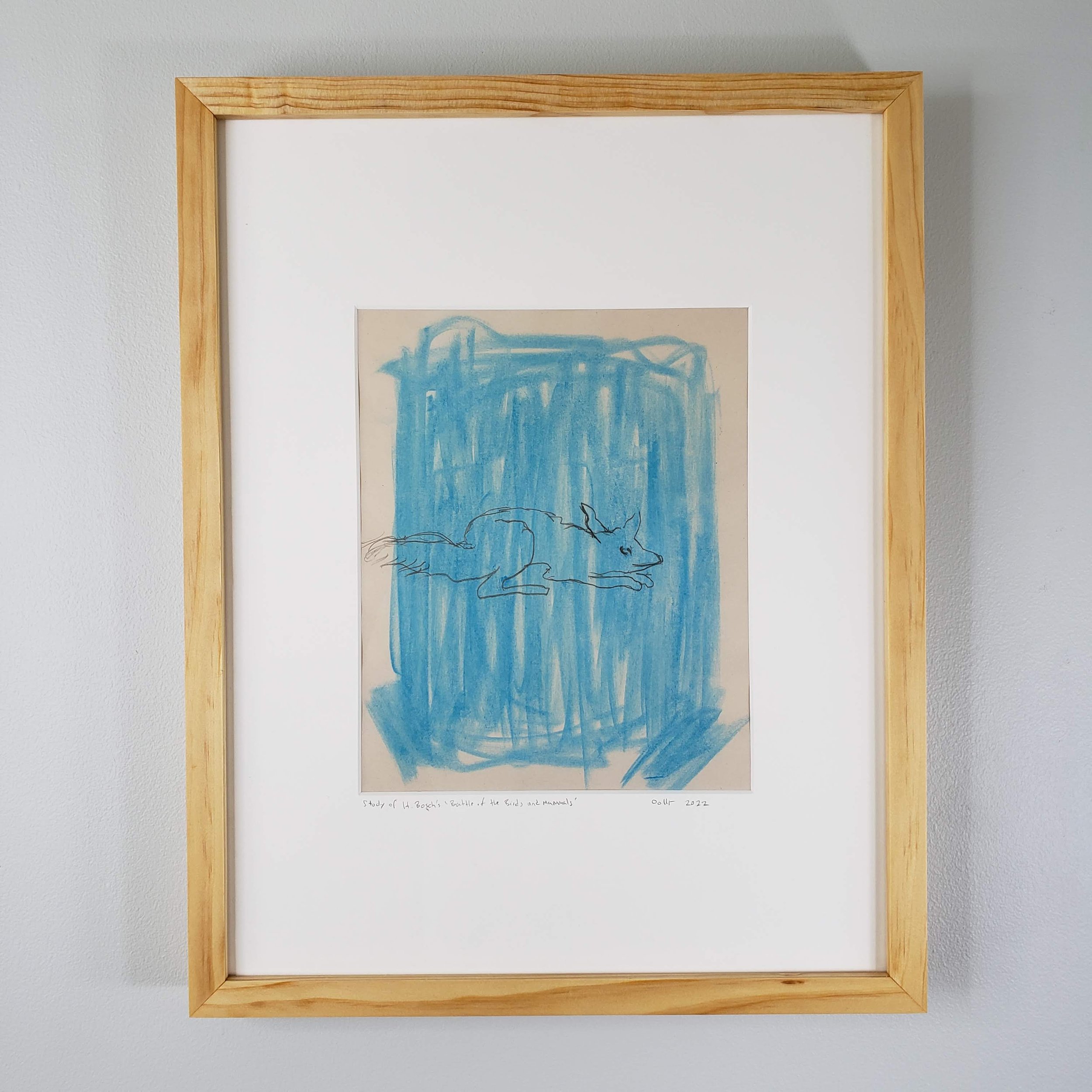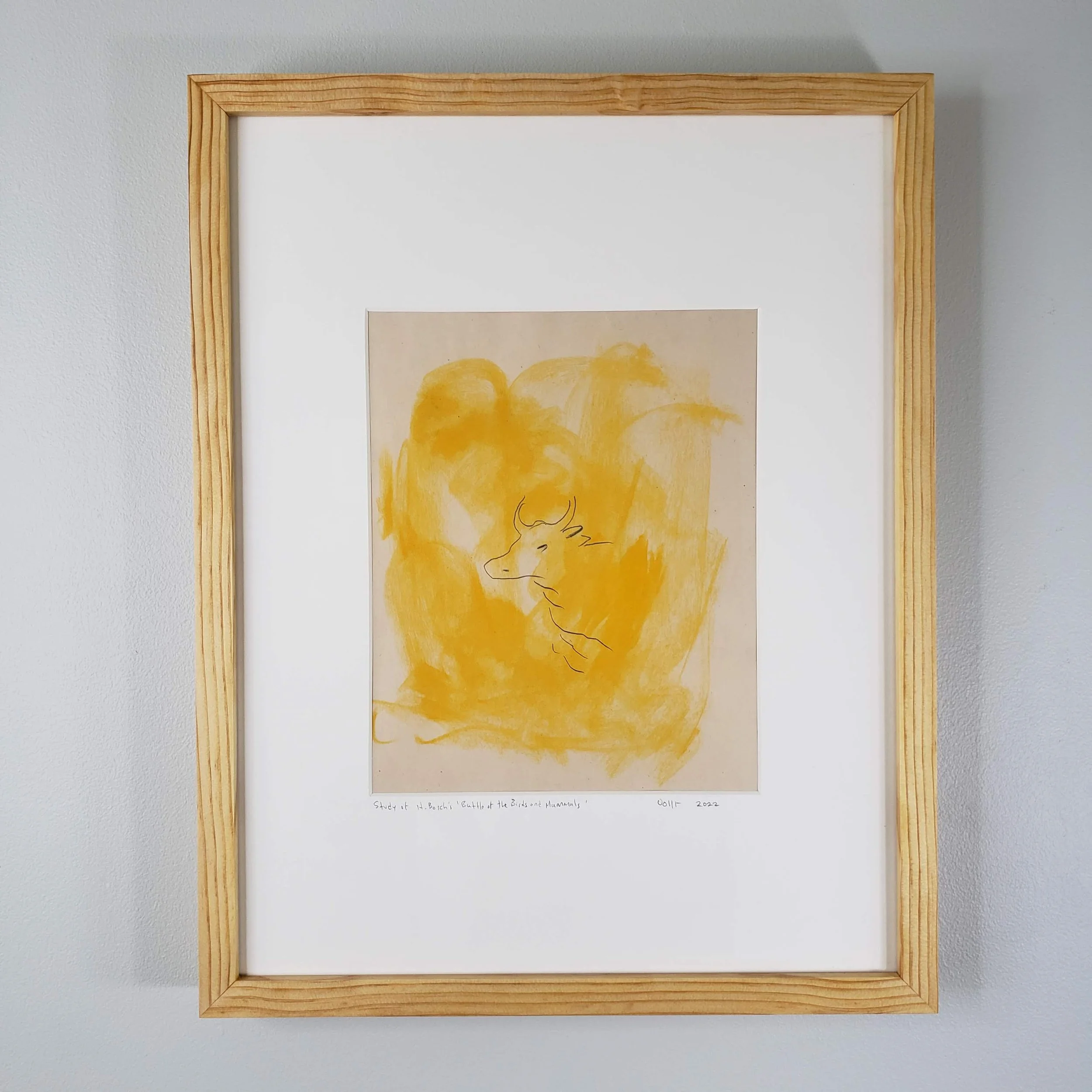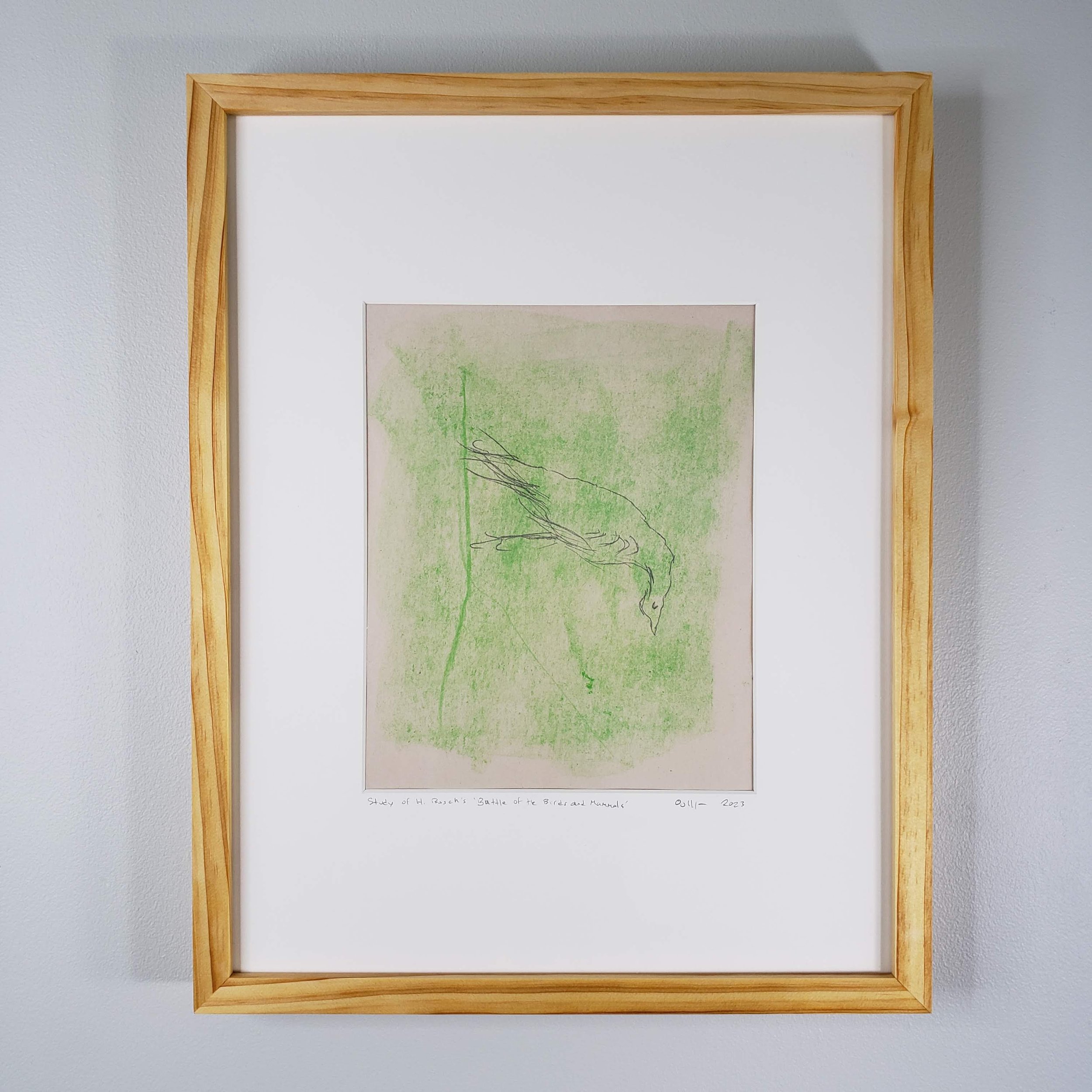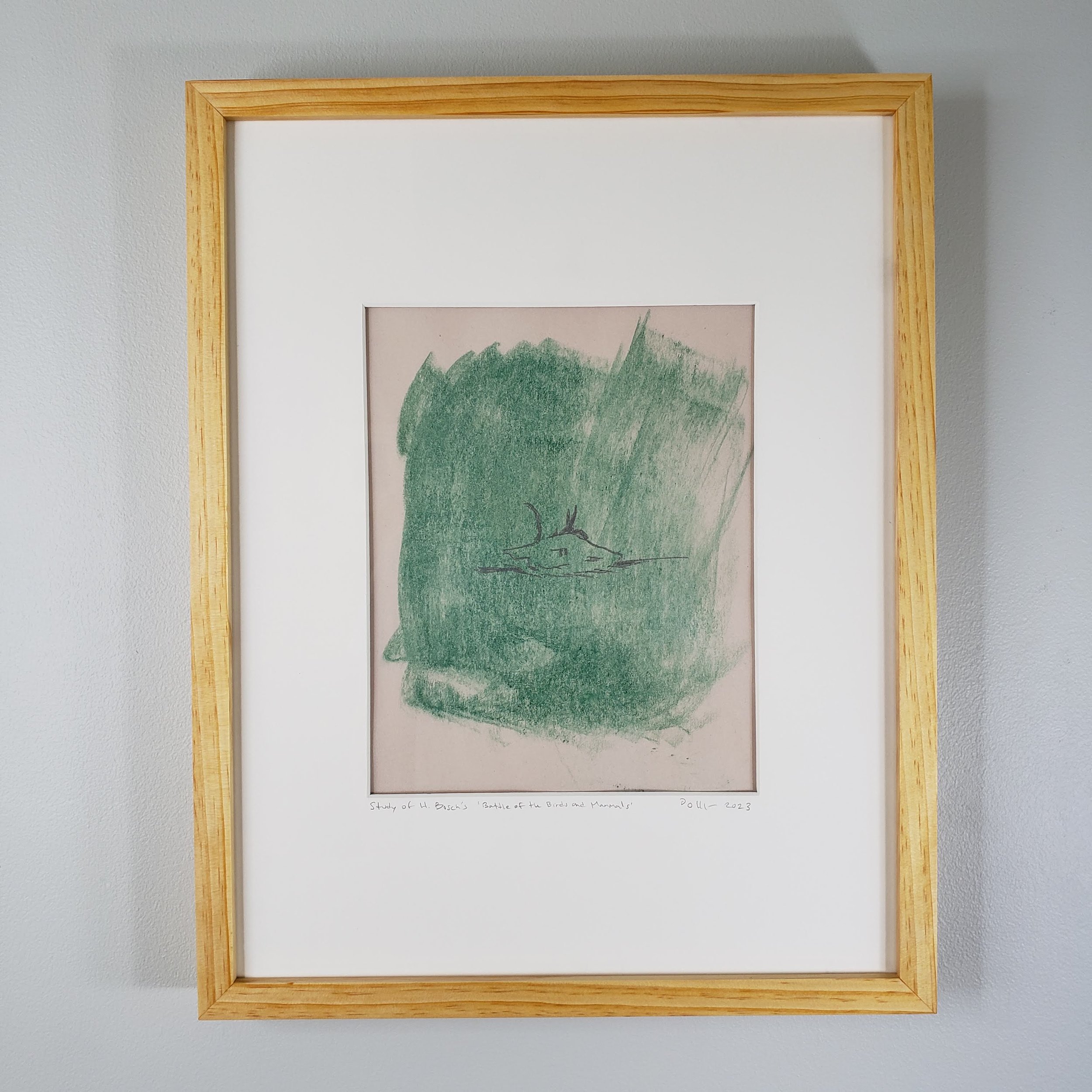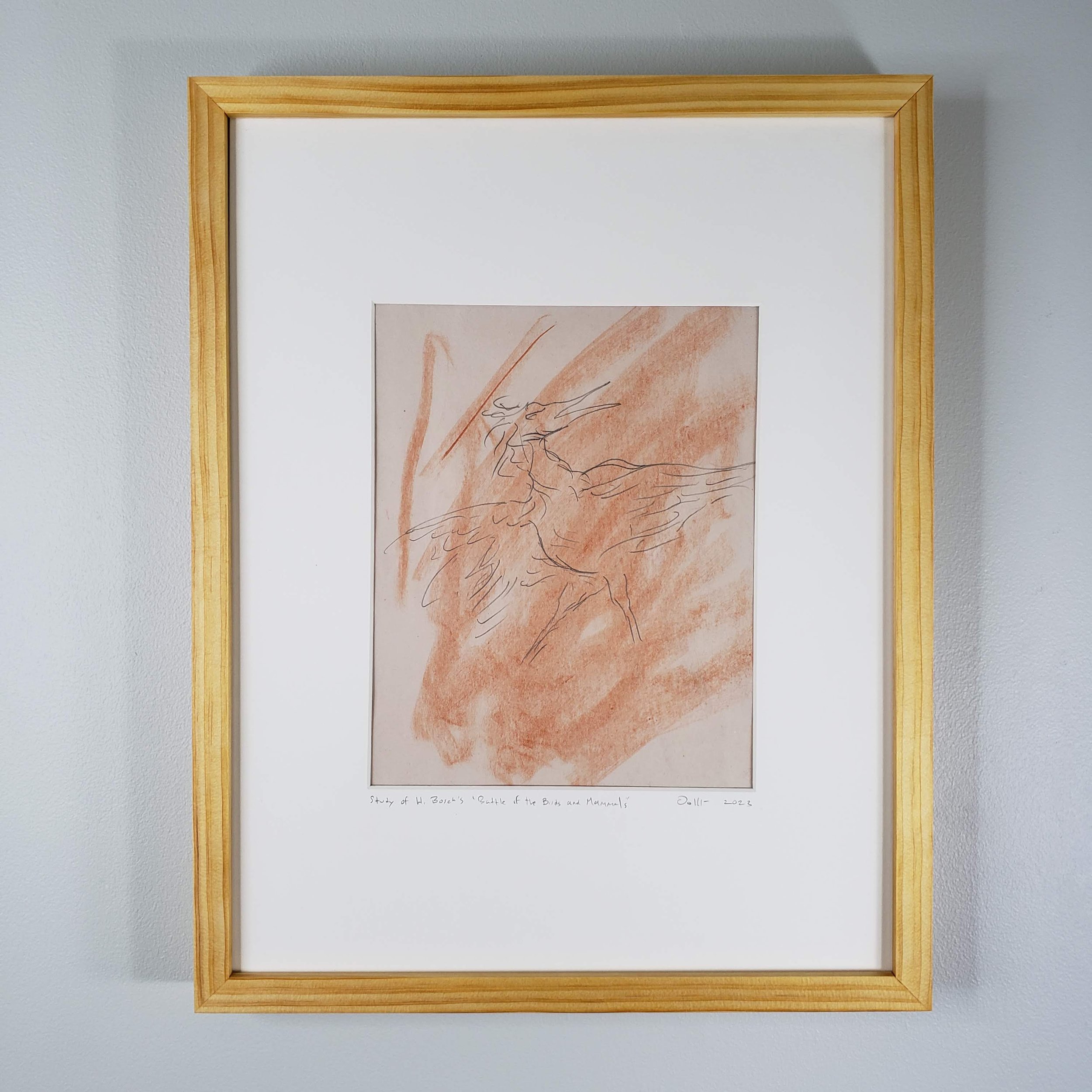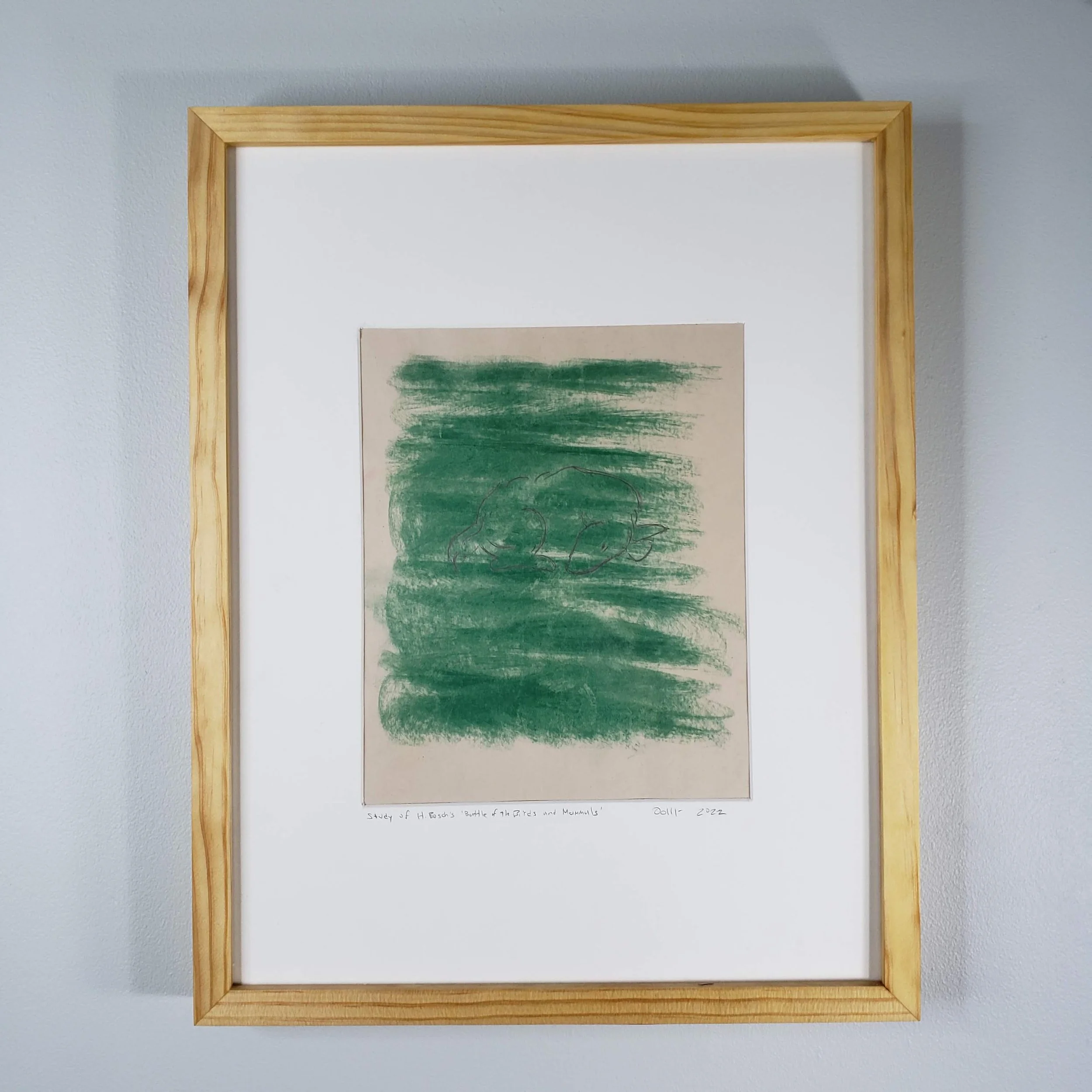Studies of Hieronymus Bosch’s “Battle of the Birds and Mammals”
2022
Series of 60 drawings
Graphite and pastel on newspaper
8 x 10 inches (15 x 19 framed)
Frames made by the artist
-
Well before it -- and a long way from the abattoir; though well on its way. In this respect unfailing: the mute obedience of staying the course, and the bizarrely comforting ensconcement afforded by docility. As perhaps the ensconcement that wood or stems provide to the bee larvae in winter. And the mirrors lining this path, these walls, like bricks or cobblestones, returning the christening of a deadened, lymphatic face.
Sheltered larvae molt into bees in Spring. But no season involuntarily stirs the human into life. Tearing with your teeth through the wall of mud that separates you from the day must come as a decision that flowers into act and flight.
But unfailing --the obsequious observance of the path-- in another respect: by virtue of the herder’s own adherence to a structure, a perennial and introjected goal, by now a mere habit or routine, itself almost beastly in its unconscious admission and daily performance; and the lines laid out by his movements, the nudging and prodding inextricable to his work, to the task of herding and shepherding; the invisible funnels he draws on fields, prairies, pasturelands -- often with the very assistance of the animal, of a certain animal that has had the “cunning,” “sense,” “impulse” (or whatever word would here describe this queer adoption, this remarkable and baffling “decision”) to link, in an extremely risky gamble, its collective existence, to wager and wed the chance of its own survival (or annihilation) to ours!
Like a dancing bear inside a human circus. And so many variations on the theme of herding and corralling.
And we cannot forget the captivation derived from captivity itself, the more engrossing the further the enclosure is to the beast’s habitat; inversely, the closer it is to our own environs, to our home’s perimeter, our dwelling’s interior, and the gestures (banal, erotic, desperate) that unfold therein. As it crosses this threshold, an unmistakable pathetic quality suffuses the animal’s mimicry of the human. The intrigue of pathos: we see it can thus be provoked --often easily, and rather anywhere-- outside of slaughter, across the street or miles from the abattoir, but well on its way to it, though again nowhere near it, which is to say any place possible. And the question of shame, caressing that of pathos: we see it provoked just as forcefully by the issue and imposition of clothing; more generally, the issue and imposition of mimesis.
Like a dancing bear inside a human circus. And so many variations on attiring, travestying, imitating.
We shrivel, we shrink back and down, almost reflexively, like pudic urchins; every day and in reaction to the least trigger, at the merest provocation. We reduce ourselves to the animal, to the blindness and impulsivity of its habit, and to the force that only within us and through us can transform itself into a violence laced with contempt -- killing with enmity. Through a reverse gesture, we reduce and defang the animal, mutilate its paws, deprive it of its own violent impulsivity, turn it into a grotesque and risible reflection of ourselves. The inadequacy, the caricature of this reflection can only provoke abhorrence and nausea. At times, this reduction is the ironic consequence of an attempted dignification or ennoblement -- lifting out of the mud what should remain in the mud. Instead, a double diminishment ensues, the absurd caricature is intensified, and derision cannot but be rendered back in the form of a presentiment that becomes, in turn, something that acquires the force of an emblem, symbolic but weighty like sand or metal, and which glimmers as the cold insignia of the double humiliation with which it has now branded us; rather, with which we have branded ourselves, risibly and stupidly, as the animals that we are not but have nonetheless chosen to mimic. This often occurs at odd and uncanny times, in and as the recollection of a betrayal to our species hiding behind the humiliation of another (an indefinite number of other) species. Circus, zoo, experimental animals, tame bears, even those we could call “pioneer” animals (monkeys, dogs, mice, fish, flies) shot into and immolated in outer space in the service of science; these curious drawings by Bosch: each returns to us, in its particular manner of voicing or screaming, this denigration, all the while returning us to the denigration that has quivered in our bosom ever since ingesting the sumptuous yet decaying fruits of language. The hearth that, momentarily and in a terrifying flash --that is to say, monstrously-- is revealed as a prison and reveals, at the same time, the revilement with which we hold our human home.
The “Battle of the Birds and Mammals” was purportedly drawn by Hyeronimous Bosch in 1500. A companion drawing exists, the “Gathering of the Birds”, which in the chronology of events that the drawings jointly present (the prelude to war, followed by its unfolding), would be viewed and considered first. We have no knowledge of a “Gathering of the Mammals,” and thus no triptych. No knowledge, either (if we care), of art history or criticism having paid much or any attention to either of these drawings, and consequently to the motivations (if we care) that spurred their creation and the themes they explore.
The “Gathering” depicts a group of birds standing around in anticipation of battle. The “Battle” presents generalized war and carnage. There is an unmistakable and captivating pathetic quality to these two scenes (the battle and its prologue). This captivation is linked, in turn, to the animal’s captivity in and by the human gesture. Again, this poignancy arises from the animal’s thoughtless imitation of the human, its indefinite, and, for us, alluring confinement inside an anthropomorphic frame, the familiar structure of its habit (killing without violence, destruction without fear) overturned and reduced, in a swift and brutal stroke, to a great dichotomy, a Manichaeism of us versus them, land- versus air-dwelling, avian versus mammal, heedless existence trembling at and kneeling to the anguish of the question, “Am I, this day, to kill or be killed?” The horror of an either/or existence.
And while the spectacle of violence would perhaps propel us, attendants to this pitiful struggle which we hold as a mirror, it would scarcely move us. Much less carry. Would war? (Yet again and as it always has)? In which case would it not be more appropriate to speak of the mobility of war, its catalyzation? Hence, not whether it would carry us, bear the weight of our triumphs and fears, but rather mobilize us, since carrying itself carries an ethics, whereas mobilizing activates a technics. Why then, on Bosch’s part, this superimposition, this uncanny calque, this pastiche of fervor and shame -- the blind hurling and hungry fever with which the human wages war -- onto the animal domain?
And is he ever really anything besides, in place of, other than human -- reduced, it’s true, to his animal portion, distilled to the vinegar of his savage part, but nonetheless and down to the bone human -- this other to be killed today lest I consent, surrender to be killed? More poignantly and disturbingly: is not a certain paraphrase of this question what we must silently articulate and answer to every day under the conditions to which contemporary society corrals us -- like the animals that we are not but nonetheless agree to mimic? Inside the self the human has discovered the continent of another self he can raze to the ground, polish down to a thing. The patina to which this self is reduced reveals something akin to the cold coruscation of gold. Hypnotized by its thingly glow, discrepant feelings and gestures are stirred: I can wrap it around me like a holy shroud or defecate on it as if its entire extent was a public latrine. (Although we should also ask whether the human could ever wage war with an other other, a nonhuman other: nature as such, the animal and plant kingdoms, the planets, physical or natural laws, viruses, microscopic life; whether the human, in short, could ever affront, confront, charge against, seek to obliterate an other that would not be aware of it -- like the ignorance of the Hellespont when whipped by Xerxes’ soldiers).
This act --the activation of war, the auto-anthropophagy it in turn activates, consumption to the bone, besides the collective jouissance it triggers-- the enjoyment of laying waste to the land on which the other inside ourselves dwells, in a kind of desperate, perverse, and self-destructive metonymy; this gesture that defaces the visage, that tears the flesh in pounds, either blind to or secretly relishing in the ignorance of contemplating its own excised liver alloyed into a pound of gold sumptuously melting like an idol under the sun.
To witness and remark on this act, to again comment on the decision by which, on our behalf and against its own nature, the animal rehearses war and its motions; the resolve of this rehearsal, on the artist’s part, leading to the animal’s subjection, perhaps even its subjectivation, its subjection to the dawn of subjectivation, warfare of one class against another, contravening every natural impulse (for predation and depredation are not in the least bellicose, but, as James Dickey reminds us in “The Heaven of Animals,” simply embody the acceptance of living in an environment that otherwise could not be the place it is without blood). Instead, another instance by which the animal gets roped in, confined, corralled into the cruel theater of humanity -- like a bear roped into the dance.
Only questions in the offering. But perhaps nothing else can be gifted to the god that may remain, nothing other than the exquisite, decaying fruit of questions -- for which, once again, we will still deserve to be killed by our brother's hand. Regardless of the fact that its aim may no longer be to please or appease, and absent the sumptuousness of flesh, the sacrificial table must be prepared -- even when we are the ones who must lay ourselves on it. Thus, does auto-anthropophagy not reveal and trigger an introjected hatred (the hatred of laying ourselves down)? Is it not accompanied by a harrowing sense of auto-repulsion -- terrible enough as to mark our foreheads? The repulsiveness occasioned by the attempt to delegate the guilt and revulsion occasioned by our own actions, perhaps even our very existence, onto this wholly intimate yet ever remote other that has become the object of our calculated and often incalculable cruelty.
Hence, to the extent that the animal is suffused with pathos by mimicry, are we ourselves suffused with shame by contemplating this scene, this spectacle? Nature moved by (violence) and toward something (war) utterly foreign to it; to behold, in short, the denaturing of nature.
The animal cannot be supine, it can never enter and dwell in this realm. Only the human can know this “activity”: lethargy born out of cowardice (not the other way around). Is the active, incarnate rendition of the animal the inverse mirror of our supinity, and does shame, like a pulsion of pus, ferment at its very origin?
At the same time is not war, like the festival, as Bataille and Caillois remind, a paroxysm whose fundamental effect is to overturn the established order, such that, in this instance, in this imagined clash between birds and mammals, the animal would somehow be justified as its agent? In other words, is not this representation not simply symbolic -- and perhaps, by extension, not merely critical -- of the logic-without-logic at the heart of war itself: the total and sudden reversal of the hierarchy of things? The pretension would be to have my shame stand to shine as my very honor; my humiliation would crown me with its rays. Bathed in the glory of supinity: what I wish to open my eyes to, once I close my eyes to this world, what I desire to fade into, would be the strange comfort of humiliation and the plush prison erected around me, cradling me to no end.
So what of the studies themselves? What about what the studies say --and the manner or style in which they say it? What is their manner of studying, if they “study” at all? And do they in fact study or merely copy, repeat what Bosch already spun before our eyes, itself an idiosyncratic, fabular study of war? We know this cannot be the case (the presumed innocence of “mere” representation) when every cut is a decision -- the decision of where to cut, and where to guide the cut -- and therefore a line, a lead, a vanguard that fundamentally marks a decision/desire which, regardless of its disguise, is entirely and to the bone human.
The studies excise a part from the whole; and fundamentally drive to fragment, to break apart a violent and harrowing assemblage. In a certain sense, they offer an exploded view of the machinery of war. Each drawing isolates, highlights, underscores, enframes a portion of the general scene. Each drawing, adrift from the others, wandering ever farther with each passing instant. Yet something besides the particular animal is excised: the violence to which it is subjected, hurled and forced into, embroiled, caught up in like a web or dynamo; the violence, too, that it itself spurs, projects and ejects in all directions; the violence it receives and the violence it distributes. Each study, an amputation and a fulmination: a display of fireworks.
The violence still exists, of course, but as an echo, and in a certain sense as a phantasmagoria, an evocation. Each drawing in effect frames, via the cut or cuts (at least by those of the line and the frame), a miniature scene severed from the general theater.
To be suspended in the study, to dwell in its recess. To be held in abeyance, in the perpetual impossibility of a final outcome or result: unconsumated killing; conversely, eternal dying.
In a way, then, the suspension to which these animals are subjected is a suspension not just in space (that of the surface), but a suspension of violence itself, a moratorium instituted by a kind of aesthetic deus ex machina. This gesture itself betrays a desire, however naive, to save the animal via sacrifice; specifically, via the only remaining claim to sacrifice in our contemporary world: the sacrifice of art.
This ritualistic death, which provides a chance to transcendence, stands in contrast to the scene that unfolds every day inside the infinite repetition of homes. The man who tells his son, “I have lived like a dog, I have worked like an animal,” and says “I have sacrificed myself for you,” in fact says the very opposite: “I have lived and died like a thing; my life has been a tool, and my death occurs in an environment without meaning.”

